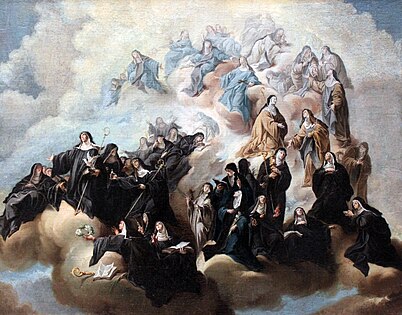Scholastica
Saint Scholastica | |
|---|---|
Pre-Congregation | |
| Feast | 10 February |
| Attributes | in Benedictine religious habit, with crozier and crucifix; with dove flying from her mouth[1] |
Scholastica (c. 480 – 10 February 543) was an Italian Christian hermit and the sister of Benedict of Nursia. She is traditionally regarded as the foundress of the Benedictine nuns.
Scholastica is honored as a saint of the Catholic Church, Eastern Orthodox Church and Anglican Communion. She was born in Italy, and a ninth-century tradition makes her the twin sister of Benedict.[2] Her feast day is 10 February.[3]
Life
According to the 6th-century
A young Roman woman of Scholastica's class and time would likely have remained in her father's house until marriage (likely arranged) or entry into consecrated life. On occasion several consecrated virgins would live together in a household and form a community.[2]
Benedictine tradition holds that Scholastica established a hermitage about five miles from
Narrative from the Dialogues

The most commonly told story about her is that Scholastica would, once a year, go and visit her brother at a place near his abbey, and they would spend the day worshiping together and discussing sacred texts and issues.[5]
One day they had supper and continued their conversation. When Benedict indicated it was time for him to leave, Scholastica, perhaps sensing that the time of her death was drawing near, asked him to stay with her for the evening so they could continue their discussions. Not wishing to break his own Rule, Benedict refused, insisting that he needed to return to his cell. At that point, Scholastica closed her hands in prayer, and after a moment, a wild storm started outside of the guest house in which they were staying. Benedict asked, "What have you done?", to which she replied, "I asked you and you would not listen; so I asked my God and he did listen. So now go off, if you can; leave me and return to your monastery." Benedict was unable to return to his monastery, and they spent the night in discussion.[5]
Three days later, from his cell, he saw his sister's
The Anglo-Saxon bishop and scholar Aldhelm recounts the story in both the De Laude Virginitatis, written for the nuns at Barking, and in the shorter Carmen de virginitate.
Studies

What is known of Scholastica derives from the Dialogues of Gregory the Great. Early calendars and place names in the area around Monte Cassino support the historical accuracy of St. Gregory the Great's account of her life.[6] Gregory names as his sources four of Benedict's contemporaries. A contemporary, Caesarius of Arles, wrote the Regula virginum (Rule for Virgins), a rule drawn up for virgins living in community, for a community which was headed by his sister, Caesaria.[7]
Veneration
Scholastica is the patron saint of Benedictine nuns, education, and convulsive children, and is invoked against storms and rain. Her feast is celebrated on 10 February.[3] Saint Scholastica's Day bears special importance in the Benedictine monastic calendar.[8]
In iconography, Scholastica is represented in a Benedictine habit, often as an abbess, and holding the Rule of Saint Benedict, with a crucifix or an ascending dove.[9]
Scholastica was selected as the main motif for a high-value commemorative coin: the Austria €50 'The Christian Religious Orders', issued 13 March 2002. On the obverse (head) side of the coin Scholastica is depicted alongside Benedict.
Scholastica is honored on the calendars of the
Gallery
-
Saint Scholastica with Nuns of the Benedictine Order and its Affiliations
-
Anne of Austria with her children (King Louis XIV and Philippe, Duke of Anjou) praying to the Holy trinity
-
Madonna and child with saints
See also
References
- ^ "Patron Saints Index: Saint Scholastica". Saints.sqpn.com. Archived from the original on 7 February 2012. Retrieved 20 May 2012.
- ^ a b c "St. Scholastica - Traditional twin of St. Benedict". www.indiana.edu. Retrieved 12 February 2020.
- ^ ISBN 978-1-56854-240-9.
- ISBN 9780814622926
- ^ a b c d e "Saint Scholastica, Virgin and Religious Founder. OSB". www.osb.org. Retrieved 12 February 2020.
- ISBN 9788472023666
- ^ Shahan, Thomas. "St. Caesarius of Arles." The Catholic Encyclopedia Vol. 3. New York: Robert Appleton Company, 1908. 10 February 2018
- ISBN 978-0-615-20507-6.
- ^ Lexikon der christlichen Ikonographie, (Kirschbaum and Bandmann, eds.),8.315-16
- ^ "The Calendar". The Church of England. Retrieved 27 March 2021.
- ^ "Scholastica of Nursia, Monastic, 543". The Episcopal Church. Retrieved 21 July 2022.
External links
- Whatley, E. Gordon, Thompson, Anne B., and Upchurch, Robert K. "The Life of St. Scholastica:Introduction", Saints Lives in Middle English Collections, Medieval Institute Publications, Kalamazoo, Michigan, 2004
- Adrienne von Speyr, ″Book of All Saints: Scholastica″, pp. 347–349. San Francisco: Ignatius Press, 2008.
- Butler, Alban. "St. Scholastica", The Lives or the Fathers, Martyrs and Other Principal Saints, Vol.I, D. & J. Sadlier, & Company, 1864
- Foley O.F.M., Leonard, "Saint Scholastica", Saint of the Day, Franciscan Media



